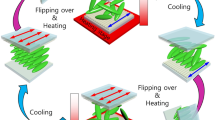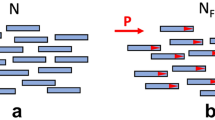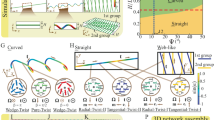Abstract
It has long been appreciated that liquid-crystal (LC) devices in which the LC molecules adopt multiple stable orientations could drastically reduce the power consumption required for high-information-content displays. But for the commonly used nematic LCs, which are intrinsically uniaxial in symmetry, no industrially feasible multi-stable LC device has been realized1,2,3,4,5,6,7. Recently we demonstrated how bistability can be robustly engineered into a nematic LC device, by patterning a substrate with an orientational chequerboard pattern that enforces orthogonal LC alignment in neighbouring square domains8,9. As a result of the four-fold symmetry of the pattern, the two diagonal axes of the chequerboard become equally stable macroscopic orientations. Here we extend this symmetry approach to obtain a tristable surface-aligned nematic LC. A microscopic pattern exhibiting six-fold symmetry is inscribed on a polyimide surface using the stylus of an atomic force microscope. The hexagonal symmetry of the microscopic orientational domains in turn gives rise to three stable macroscopic LC orientations, which are mutually switchable by an in-plane electric field. The resulting switching mode is surface driven, and hence should be compatible with demanding flexible display applications.
This is a preview of subscription content, access via your institution
Access options
Subscribe to this journal
Receive 51 print issues and online access
$199.00 per year
only $3.90 per issue
Buy this article
- Purchase on Springer Link
- Instant access to full article PDF
Prices may be subject to local taxes which are calculated during checkout



Similar content being viewed by others
References
Yokoyama, H. Handbook of Liquid Crystal Research Ch. 6 (eds Collings, P. J. & Patel, J. S.) (Oxford Univ. Press, New York, 1997)
Boyd, G. D., Cheng, J. & Ngo, P. D. T. Liquid-crystal orientational bistability and nematic storage effects. Appl. Phys. Lett. 36, 556–558 (1980)
Berreman, D. W. & Heffner, W. R. New bistable liquid-crystal twist cell. J. Appl. Phys. 52, 3032–3039 (1981)
Scheffer, T. J. & Nehring, J. A new, highly multiplexable liquid crystal display. Appl. Phys. Lett. 22, 1021–1023 (1984)
Yang, K. H. Weak boundary storage effect in homogeneous liquid crystal cells. Jpn J. Appl. Phys. 22, 389–393 (1983)
Ong, H., Meyer, R. B. & Hurd, A. J. Multistable orientation in a nematic liquid-crystal cell induced by external-field and interfacial interaction. J. Appl. Phys. 55, 2809–2815 (1984)
Barberi, R., Boix, M. & Durand, G. Electrically controlled surface bistability in nematic liquid crystals. Appl. Phys. Lett. 55, 2506–2508 (1989)
Kim, J. H., Yoneya, M., Yamamoto, J. & Yokoyama, H. Surface alignment bistability of nematic liquid crystals by orientationally frustrated surface patterns. Appl. Phys. Lett. 78, 3055–3057 (2001)
Kim, J. H., Yoneya, M., Yamamoto, J. & Yokoyama, H. Controlling surface alignment on nanoscopically tailored competing domains. Mol. Cryst. Liq. Cryst. 367, 151–158 (2001)
Blinov, L. M. & Sonin, A. A. The interaction of nematic liquid crystals with anisotropic substrates. Mol. Cryst. Liq. Cryst. 179, 13–25 (1990)
Schuddeboom, P. C. & Jerome, B. Azimuthal anchoring of liquid crystals on surfaces with high symmetry. Phys. Rev. E 56, 4294–4305 (1997)
Schuddeboom, P. C. & Jerome, B. Multistable bulk orientation induced by highly symmetric liquid-crystal monolayer. Europhys. Lett. 39, 515–520 (1997)
Yoneya, M., Kim, J. H. & Yokoyama, H. Simple model for patterned bidirectional anchoring of nematic liquid crystal and its bistability. Appl. Phys. Lett. 80, 374–376 (2002)
Ruestschim, M., Grutter, P., Funfschilling, J. & Guntherodt, H. J. Creation of liquid crystal waveguides with scanning force microscopy. Science 265, 512–514 (1994)
Pidduck, A. J., Haslam, S. D., Bryan-Brown, G. P., Bannister, R. & Kitely, I. D. Control of liquid crystal alignment by polyimide surface modification using atomic force microscopy. Appl. Phys. Lett. 71, 2907–2909 (1997)
Rastegar, A., Skarabot, M., Blij, B. & Rasing, Th. Mechanism of liquid crystal alignment on submicron patterned surfaces. J. Appl. Phys. 89, 960–964 (2001)
Kim, J. H., Yoneya, M., Yamamoto, J. & Yokoyama, H. Nano-rubbing of a liquid crystal alignment layer by an atomic force microscope: a detailed characterization. Nanotechnology 13, 133–137 (2002)
de Gennes, P. G. & Prost, J. The Physics of Liquid Crystals (Oxford Univ. Press, New York, 1993)
Yamaguchi, R. & Sato, S. Determination of nematic liquid crystal (NLC) orientation by observing NLC droplets on alignment surfaces. Jpn J. Appl. Phys. 35, L117–L119 (1996)
Author information
Authors and Affiliations
Corresponding author
Ethics declarations
Competing interests
The authors declare that they have no competing financial interests.
Rights and permissions
About this article
Cite this article
Kim, JH., Yoneya, M. & Yokoyama, H. Tristable nematic liquid-crystal device using micropatterned surface alignment. Nature 420, 159–162 (2002). https://doi.org/10.1038/nature01163
Received:
Accepted:
Issue Date:
DOI: https://doi.org/10.1038/nature01163
This article is cited by
-
Shape and structural relaxation of colloidal tactoids
Nature Communications (2022)
-
Artificial colloidal liquid metacrystals by shearing microlithography
Nature Communications (2019)
-
Programming emergent symmetries with saddle-splay elasticity
Nature Communications (2019)
-
Transition from Spin Dewetting to continuous film in spin coating of Liquid Crystal 5CB
Scientific Reports (2018)
-
Transport of ions and electrons in nanostructured liquid crystals
Nature Reviews Materials (2017)
Comments
By submitting a comment you agree to abide by our Terms and Community Guidelines. If you find something abusive or that does not comply with our terms or guidelines please flag it as inappropriate.



